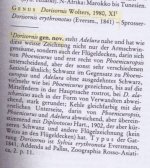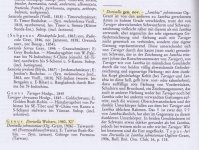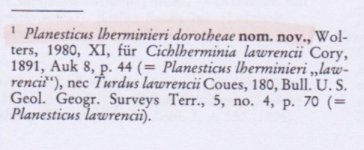Captain Cook’s journal:
1st February 1769
Off Cape Horn
First part, fresh Gales; latter, light Airs and Cloudy; P.M. found the Variation by several Azimuth to be 24 degrees 53 minutes East. At Noon sounded, but had no ground with 240 fathoms of line; hoisted a Boat out to try if there was any Current, but found none. The weather was such as to admit Mr. Banks to row round the Ship in a Lighterman's Skiff shooting birds.
Joseph Banks Journal (same date)
Calm this morn: went out in the boat and Killd Diomedea antarctica, Procellaria antarctica and turtur. Diomedaea antarctica the Black billd albatross is much like the common but differs from him in being scarce half as large and having a bill intirely black. Procellaria lugens the Southern shear water differs from the common one in being less and darker colourd on the back, but is easily distinguishd by his flight which is heavy, and two fascia or streaks of white under his wings which are very conspicuous when he flies.
Forster by Lichtenstein 1844:
Inter species huius generis a Kuhlio et Lalhamo recensitas
nullam video praeler P. griseam Gmelini, quae descriptioni huic For-
sterianae respondeat. Conferantur modo, quae Kuhlius de caudae for-
ma, remigum longitudine et pedum pictura perhibet cum Lathami
descriptione in synopsi et indice, praesertim ubi de specimine Leve-
riano (mento juguloque candidis insigni) loquitur. P t melanopus Gmel.
et Lath. fortasse nonnisi aetate a P. grisea differt.
Kuhl provided a drawing of Procellaria grisae (9) but not Pr. lugens.
https://www.biodiversitylibrary.org/item/89679#page/427/mode/1up .
There are two images by Sydney Parkinson nos. 21 and 22 which would be nice to see.
Parkinson no 31 and 25
https://nhmimages.com/?service=asse...43,10073,10271,10058&basket_item_id=undefined .
https://nhmimages.com/?service=asse...10232,8165,8171,8159&basket_item_id=undefined .
Lesson Pr. brevirostris
https://www.biodiversitylibrary.org/item/111050#page/649/mode/1up .
Perhaps there needs to be a neotype.
http://www.scielo.br/scielo.php?script=sci_arttext&pid=S1984-46702016000604003 .
https://archive.org/stream/biostor-75755/biostor-75755_djvu.txt .









